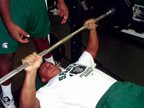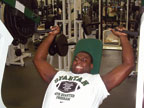Strength training: No substitute for hard work
With all of the trendy strength training approaches available these days, it becomes easy to lose sight of the single-most important premise of all – hard work.
Regardless of your basic beliefs and training philosophy, we all know that there are occasions – primarily in the off-season – when it is advantageous from both physical and mental perspectives to insert highly challenging workout scripts. These are workouts that exceed the norm by several notches on the intensity scale.
The rationale for their implementation can vary: They may fit well with your current training cycle, the athletes and coaches are ready for a turn off the beaten path to provide a different stimulus, or you simply want to generate some enthusiasm and emphasize the carry-over benefits of good old-fashioned hard work.Hard Training With Time Under Load
Strength training paradigms are abundant and vary from the schools of High Intensity (or High Tension) Training, solely Olympic style lifts and their analogues, traditional Powerlifting, and/or the combination of all of the above. Throw in everything available in the free weight family, the wealth of machine designs, and the now popular “functional” training activities, and you will find several designs melded into a workable system.
While some practitioners will recognize the following routines as being very similar to their current approach, others will find certain aspects to be somewhat removed from normal daily operating procedures. In either situation, the fact that these scripts are meant to be used intermittently usually suppresses any major concerns about deviating from the status quo.
The training scripts to be described here rely – for the most part – on the time under load (TUL) concept. TUL is a general term that refers to rep duration – i.e., the amount of time tension is created and maintained within the working musculature during a rep specifically, and the set ultimately.
Recommendations on TUL are wide in scope and can be manipulated in an undulating fashion. In these particular workout scripts, we shoot for a five to six second rep – i.e., 2 seconds for the positive (raising) phase, and 3-4 seconds for the negative (lowering) phase.
With that very basic information as a backdrop, let’s look at some hard training scripts utilizing this concept.

The Lower Body
The first lower body script involves three cycles (12 total sets) of three different multi-joint exercises and one single-joint exercise performed in the listed sequence. As a general rule, a target of eight solid reps is set for each exercise in all three cycles with 1-3 minutes (depending upon the conditioning and tolerance level of the athlete) of recovery between sets.
It looks like this:
- Front Squat – 8
- Dead Lift – 8
- Leg Press – 8
- Romanian Dead Lifts (RDL’s) – 8
Rest 3-4 minutes, and then repeat the sequence two more times.
Note: The RDL’s are commonly referred to as “straight-legged” dead lifts, but since there should be an ever so slight bend maintained in the knees, we prefer the RDL terminology.
The second script alternates three multi-joint exercises with three single-joint exercises. Three rotations through (18 total sets) are performed, with the reps/recovery allotments remaining the same as the first script.
- Back Squat – 8
- Leg Curl – 8
- Lunges – 8 each leg
Leg Extension – 8
Step-Ups onto 24″ inch box (alternate legs) – 8 each leg
Hip/Back Extensions – 8
Rest 3-4 minutes and repeat the sequence two more times.
Note: A weight vest or dumbbells can be used for additional resistance on the step-ups.
The third script calls for three consecutive sets of three multi-joint exercises, followed by two consecutive sets each of two single-joint movements. Once through the entire sequence (13 total sets) will suffice. The multi-joint sets are performed in a 10-8-6 pyramid fashion, with workable weight increments on each set. The single- joint exercises are executed within a range of 8-10 reps. Allow for a 2-3 minute recovery period between all exercises.
The sequence looks like this:
- Back Squat – 10/8/6
- Leg Curl – 8-10 rep range (2 consecutive sets)
- Front Squat – 10/8/6
- Low Back Extension – 8-10 rep range (2 consecutive sets)
- Leg Press – 10/8/6
Coaching Points: Weight loads can be determined in one of two ways: Percentages of tested exercises (e.g., squat) can be assigned to the corresponding target reps, or they can be dictated by perceived effort (i.e., choosing loads that require a high level of effort without compromising technique). It is vitally important to be a stickler with correct lifting techniques, especially when squatting. Also, weight increments should be made judiciously and with the approval of the supervising coach for obvious safety reasons.
Upper Body
This is where we really like to deviate from the norm due to the wide range of options – in both exercises and equipment – at our disposal.

In this first script, we are executing a basic “press/pull” format with a 6-8 rep range assigned to all of the exercises. Three cycles of six exercises (18 total sets) are performed with 1-2 minutes relief between sets, and 2-3 minutes recovery between cycles.
The sequence looks like this:
- Dumbbell (DB) Bench Press – 6-8 rep range
- DB Bent -Over Rows – 6-8 rep range
- DB Incline Press – 6-8 rep range
- Overhand Pull-ups – 6-8 rep range
- Standing DB Military Press – 6-8 rep range
- Underhand Chin-ups – 6-8 rep range
Note: A weight vest or weighted belt can be used for the pull-ups/chin-ups.
The second script calls for a “press emphasis,” as all of the pressing movements are performed for three pyramid sets of 10/8/6. A pulling movement is placed between each press for one hard set each in the 6-8 rep range. This routine encompasses twelve total sets, with recovery periods between sets and exercises usually in the 2-3 minute range.
Here is one example of this set-up:
- Barbell Bench Press – 10/8/6
- Horizontal Row – 6-8 rep range
- Standing Barbell Military Press – 10/8/6
- High Pull or Upright Row – 6-8 rep range
- Barbell Incline – 10/8/6
- Lat Pulldown or High Row – 6-8 rep range
A complementary script that would be performed on the next upper body outing would be one with a “pull emphasis.”
It could look something like this:
- Barbell Bent-Over Row – 10/8/6
- DB Incline Press – 6-8 rep range
- Horizontal Row – 10/8/6
- Standing Barbell Military Press – 6-8 rep range
- High Pull or Upright Row – 10/8/6
- Barbell Incline – 6-8 rep range
Coaching point: Just as with the lower body scripts, the weight loads here could be percentage based or determined via perceived effort.
Final Rep
An important footnote is that these scripts are not meant to replace any phase of your existing program – especially if the basic premise and TUL protocol do not match-up with your day-to-day training approach.
Remember, these are change-up scripts to be used at your discretion, and their administration can be tweaked in any manner you deem necessary to better fit your needs and to parallel your training philosophy.
Other than that, have some fun with them. Your athletes might just enjoy the variety and change of pace.
TIP FROM THE TRENCHES
Healthier Holiday meal planning: Ah yes, the wonderful Christmas Holidays will soon be cooking-up some mouth-watering aromas in households everywhere. And with them comes some serious belt loosening that can linger well into the New Year.
Now, no one wants to be a total Scrooge and mess with all of the goodies that everyone looks forward to this time of year. However, there are a few easy techniques you can implement to reduce some of the fat calories without throwing all of the taste out in the snow.
Since none of the agility drills you’ve picked-up from reading Coach & AD this year are going to help you side-step all of those extra calories, here are some tips that you might want to pass along to your wife, mom, or whoever is wearing the chef’s hat this year:
Roast the turkey on a rack so that the fat falls through and the meat doesn’t absorb the drippings. It is also a good idea to remove the skin before eating.
The fat can be skimmed from gravies with the use of a fat separator.
Cook your stuffing outside the turkey, as stuffing cooked inside the bird absorbs a lot of fat. Also, use less butter/oil/margarine when sautéing the onions and celery to be used with the stuffing.
Instead of serving mashed potatoes with a lot of heavy butter, use skim milk and/or low sodium vegetable/chicken broth. Another option is sweet potatoes with a low-fat or fat-free salad dressing.
With pies and other baked goodies, reduce the amount of sugar (at least by a third), use skim milk or low-fat dairy products instead of whole or 2% (which still has a considerable amount of fat) milk, and use egg whites/egg substitutes in place of whole eggs. All of this can be done without negatively affecting the taste or texture of the goodies.
Hey, you can cheat a little bit when you go to grandma’s!
Have a safe, enjoyable, and blessed Holiday Season with your loved ones!
Ken Mannie
About the Author
Ken Mannie is the head strength/conditioning coach at Michigan State University. ([email protected])





